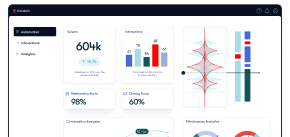In today’s experience-driven economy, your contact center is the heart of your brand. Every interaction is a moment of truth that can either build loyalty or break trust. But how do you ensure every agent consistently delivers the best possible experience?
The answer lies in transforming your approach to quality management (QM). Modern QM strategies and solutions move beyond simple compliance and random call monitoring. Instead, they strive to build a data-driven engine for continuous improvement—empowering your agents with the insights they need to excel and turning every customer conversation into a rich source of intelligence.
Learn more about the evolution of QM and the key pillars of any modern program below—plus, get a checklist you can use to evaluate potential solutions.
What Is Quality Management?
Contact center quality management is the systematic process of monitoring, analyzing, and improving agent performance to ensure consistent and continuously improving customer interactions. Historically, this involved managers manually listening to a small, random sample of calls to check for script adherence and policy compliance.
Today, modern QM can be far more powerful. It has evolved into a holistic, technology-driven discipline that integrates interaction analytics and intelligent automation to evaluate 100% of customer conversations across every channel—from voice to chat, email, and social media—and enhance manual reviews, coaching, and agent development.
Beyond Compliance Checks: The Benefits of Modern QM
As it’s evolved, the goal of modern QM has grown beyond merely “catching mistakes.” Rather than a reactive process, QM is now relied upon to proactively:
- Empower Agents: QM can provide agents with clear, objective feedback, targeted coaching, and self-service tools to take ownership of their professional development.
- Enhance the Customer Experience: The best QM programs identify the specific agent behaviors that lead to customer satisfaction and loyalty, and help replicate them across the entire team.
- Drive Business Intelligence: Uncover root causes of customer friction, identify process improvement opportunities, and share valuable voice-of-the-customer insights with the wider organization.
Ultimately, quality management is the cornerstone of a customer-centric contact center, responsible for creating a virtuous cycle where engaged, empowered, and high-performing agents deliver outstanding experiences.
The Pillars of a Modern Contact Center Quality Assurance Program
An effective quality program is built on a foundation of technology, strategy, and a commitment to people. To move beyond simple compliance and craft a program that genuinely improves performance, your approach should strive to accomplish these strategic goals.
From Manual Reviews to Automated Insight: The Evolution of Quality Monitoring
While the goal of quality management—improving agent performance and the customer experience—has remained constant, the methods for achieving it have evolved dramatically. Understanding this evolution helps clarify why modern, analytics-driven approaches deliver insights that older, manual-only methods simply cannot match.
The Traditional Approach: Random Sampling
For decades, the standard approach to QM was random sampling. In this model, a quality team reviews a very small fraction of interactions (typically 1-3%) with the hope of getting a representative snapshot of overall performance.
The Limitation: This method is fundamentally flawed. A small sample size is not statistically significant and often misses both the most critical agent errors and the most brilliant moments of service. It leaves organizations blind to 97% or more of their customer conversations, forcing them to make broad assumptions based on incomplete and often misleading data.
A Step Forward: Targeted Monitoring
To overcome the limitations of random sampling, many organizations adopted targeted monitoring. This approach focuses manual reviews on specific, pre-defined interaction types, such as those with a long handle time, those involving a cancellation request, or those that resulted in a low survey score.
The Limitation: While more focused than random sampling, this approach is still a manual, reactive process. It relies on supervisors guessing which interactions might be important and requires significant time and effort to find them. Critical issues and coachable moments that don’t fit the pre-defined criteria can still frequently go unnoticed.
The Modern Standard: Analytics-Driven Quality Management
The current gold-standard approach transcends the limitations of manual reviews by using technology to create an automated, intelligent, and comprehensive quality program. This approach leverages AI-powered Auto QM solutions to analyze 100% of interactions across all channels.
Instead of guessing, the system automatically identifies the most impactful interactions that require human attention. Supervisors can be proactively alerted to conversations containing high customer frustration, compliance risks, or exceptional service, enabling them to spend less time searching and more time coaching.
According to recent research, Auto QM is the top use of AI among contact centers. Nearly every contact center surveyed described Auto QM as important—and the level of importance ascribed to Auto QM grows in direct correlation to the size of the contact center. After all, an automation-driven approach to QM is the only way to get a complete view of performance.
Automation Isn’t Everything: The Role of Manual Evaluations in QM
While AI-powered QM automates the evaluation of all interactions, that doesn’t mean it eliminates manual evaluations entirely: In fact, 78.5% of companies still feel supervisor evaluations are necessary. This majority opinion isn’t about AI oversight—it’s about adding a layer of human expertise to get the best of both worlds.
While AI can surface quality and sentiment insights at scale, supervisors remain vital for:
- Interpreting Nuance: Adding a human understanding to AI-surfaced data, deciphering the complex emotions, sarcasm, or underlying intent in a conversation that an algorithm might miss.
- Validating Complex Scenarios: Acting as the final authority on “edge cases” or unusual interactions where automated scoring may not fully capture the context of the customer’s unique problem or the agent’s creative solution.
- Delivering Effective Coaching: Transforming analytical data into personalized, human-centric coaching that addresses the specific strengths and challenges of each agent, fostering development in a way that pure automation cannot.
Quality Monitoring Technology: The Stack Driving Performance at Today’s Contact Centers
Effective quality assurance isn’t about having a collection of separate tools; it’s about leveraging a unified technology stack where each component works together. Beyond Auto QM capabilities, these core technologies form the foundation of a modern, data-driven QM program.
Omnichannel Recording & Capture
The foundation of any QM program is the ability to securely capture 100% of interactions. A modern platform records the complete experience—including both voice audio and agent screen activity—across all customer channels, from calls to chats, emails, and social media. This comprehensive capture must be done in a way that ensures security and regulatory compliance, such as PCI redaction.
Interaction Analytics
The analytics engine is the brain of the modern QM platform. The latest solutions use AI to automatically and accurately transcribe every conversation into text. They then analyze that text to identify key topics, detect customer sentiment and emotion, and score interactions against key criteria. This is what enables you to move from random sampling to analyzing every conversation for risk and opportunity.
Desktop Analytics & Live Monitoring
To understand agent performance, you need to see how they work. Desktop analytics tracks the applications and workflows agents use during interactions, revealing system inefficiencies or knowledge gaps. This same technology enables live monitoring, giving supervisors a real-time view of an agent’s audio and screen to provide immediate, in-the-moment coaching and support during difficult conversations.
Data Integration & Customer Feedback
An interaction doesn’t exist in a vacuum. A powerful QM platform integrates with other business systems to provide a complete picture. This involves attaching metadata from your CRM (like customer history or value) to the interaction recording and linking direct customer feedback from post-call surveys (like CSAT or NPS) to the specific conversation that generated the score.
Your RFP Checklist: Finding the Best Contact Center Quality Management Solution
Choosing the right QM solution can make all the difference to your contact center performance. But evaluating potential options must go beyond surveying a list of included tools. Use these questions to go deeper with your evaluation and find the right solution.
Unified Platform & Analytics Integration
Is the QM solution integrated within a unified suite, or is it a separate product that requires complex integration?
Can you automatically build evaluation worklists based on specific keywords, sentiment scores, or predictive NPS scores surfaced by integrated analytics?
Does the platform allow you to click from a quality evaluation form directly into the full interaction recording (voice and screen) without launching a separate application?
Can QM performance data be connected with workforce management data (e.g., adherence, absenteeism) and agent-facing dashboards in a single interface?
Automation & AI-Powered Evaluation
Does the platform leverage AI to move beyond the limitations of manual, random sampling?
Does the solution allow you to automatically score 100% of interactions against foundational criteria (e.g., script adherence, compliance statements), freeing evaluators to focus on subjective soft skills?
Can the system automatically identify and surface the most critical interactions for manual review (e.g., high-frustration calls, exceptional service examples, compliance failures)?
Is the scoring process transparent and flexible, allowing you to build complex, data-driven scorecards with conditional logic and automated pass/fail triggers?
Performance Coaching & Agent Empowerment
Does the platform facilitate a collaborative coaching culture rather than a top-down evaluation process? Ask:
Is there an integrated performance management solution? Can managers create, assign, and track coaching sessions tied directly to specific evaluations?
Do agents get access to their own dashboards to view progress against KPIs, review their interactions, and perform self-evaluations?
Does the system include features for calibration and disputes to ensure scoring is fair, consistent, and transparent across the entire team?
Final Thoughts: Empower Your Contact Center with Intelligent QM
The best quality management programs deliver value far beyond the walls of the contact center. While traditional methods focused narrowly on agent compliance, a modern, analytics-driven approach transforms your customer interactions into a goldmine of coaching opportunities, customer insights, and business intelligence.
Harnessing the full potential of your data isn’t just a matter of strategy; it also requires a platform that delivers a unified view of performance, powered by built-in AI.
With a complete view of your contact center, you can manage what you measure with total confidence. Critical compliance failures, moments of customer frustration, and outstanding agent successes no longer go unseen—ensuring that your coaching efforts are focused on the moments that matter most.





